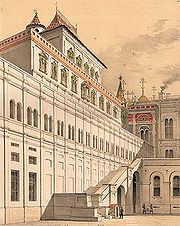
Terem Palace
Encyclopedia

Moscow Kremlin
The Moscow Kremlin , sometimes referred to as simply The Kremlin, is a historic fortified complex at the heart of Moscow, overlooking the Moskva River , Saint Basil's Cathedral and Red Square and the Alexander Garden...
, Russia
Russia
Russia or , officially known as both Russia and the Russian Federation , is a country in northern Eurasia. It is a federal semi-presidential republic, comprising 83 federal subjects...
, which used to be the main residence of the Russian tsar
Tsar
Tsar is a title used to designate certain European Slavic monarchs or supreme rulers. As a system of government in the Tsardom of Russia and Russian Empire, it is known as Tsarist autocracy, or Tsarism...
s in the 17th century. Its name is derived from the Greek word τερεμνον (i.e., "dwelling"). Currently, the structure is not accessible to the public, as it belongs to the official residence of the President of Russia.
On the 16th century Aloisio the New
Aloisio the New
Aloisio the New, known in Russian as Aleviz Novyi or Aleviz Fryazin, was an Italian Renaissance architect invited by Ivan III to work in Moscow...
constructed the first royal palace on the spot. Only the ground floor survives from that structure, as the first Romanov
Romanov
The House of Romanov was the second and last imperial dynasty to rule over Russia, reigning from 1613 until the February Revolution abolished the crown in 1917...
tsar, Mikhail Feodorovich, had the palace completely rebuilt in 1635-36. The new structure was surrounded by numerous annexes and outbuildings, including the Boyar Platform, Golden Staircase, Golden Porch, and several turrets. On Mikhail's behest, the adjoining Golden Tsaritsa's Chamber, constructed back in the 1560s for Ivan IV's wife, was surmounted with 11 golden domes of the Upper Saviour Cathedral. The complex of the palace also incorporates several churches of earlier construction, including the Church of the Virgin's Nativity from the 1360s.

Russian Revival
The Russian Revival style is the generic term for a number of different movements within Russian architecture that arose in second quarter of the 19th century and was an eclectic melding of pre-Peterine Russian architecture and elements of Byzantine architecture.The Russian Revival style arose...
style (picture).

